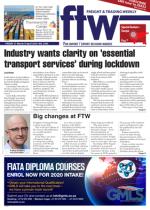A multi-faceted project that will see Botswana, Zimbabwe and Mozambique collaborate around a new railway corridor of some 1 700 kilometres, which involves the development of a deep-water port about 70km south of Maputo, is going ahead.
Although the line will also cater for passenger traffic across the region, its main objective will be to help Botswana to ship high-grade coal from its eastern mine fields to a new port at Techobanine.
The heavy-haul line was first mooted in 2011 and has been subjected to on-again off-again treatment by the various governments involved, with several memorandums of understanding dotting its timeline.
From maps seen by FTW, it will arc north-east from Selebi-Phikwe in Botswana into Zimbabwe before heading south-east into Mozambique where it will dip directly south past Maputo before making its way to the coast. “We always thought it was a crazy idea,” Roelof van Tonder of Africa House told delegates at a Transport Forum recently.
But at a port and rail conference attended by the trade consultancy executive last year, rail freight parastatal Portos e Caminhos de Ferro de Moçambique told delegates the Techobanine project was “back on”.The project’s aim, as Van Tonder confirmed, was for Botswana to bypass South Africa altogether as the landlocked country moved closer to tapping into 212 billion tonnes of fine-grain coal. That much has been confirmed by Botswana President Mokgweetsi Masisi, who gave the project his full support during a visit to Harare last year.
He also mentioned plans to ship coal west through Botswana’s hinterland into Namibia and out via the Port of Walvis Bay.And although the Trans-Kalahari line has been subjected to the same kind of on-again off-again treatment as the Techobanine project, but for much longer, both bulk-freight options for Botswana’s vast coal deposits fly in the face of a coal-freight agreement it has with South Africa.
According to the latter agreement, Botswana Railways and Transnet Freight Rail (TFR) have signed an MoU to build a 150km cross-border rail link to Lephalale in Limpopo from where coal can be shipped out via existing rail infrastructure through the Port of Richards Bay.
Building the linkage from Botswana’s coal fields to the rail-connecting point in South Africa was practically a fait accompli, TFR capital planning GM Brian Monakali said at the time he was interviewed about the agreement.He said it would cost about US$300 million to build such a link.
The Techobanine line, in comparison, is expected to cost around $600 million, split three ways between Botswana, Zimbabwe and Mozambique – an estimate that dates back to 2016 and which excludes the necessity for private-public partnership contributions.
Moreover, it will take around six years to complete.Given the cost, time and proximity benefits of shipping coal out via the existing heavy-haul line from Lephalale to Richards Bay, Botswana’s government viewed its agreement with South Africa as “the biggest thing” for his country. That’s what Botswana Trade Investment Centre executive Moshie Ratsebe told the Johannesburg Chamber of Commerce and Industry last year. Considering the feasibility of building such a line into South Africa for Botswana’s long-term coal-exporting interests, Ratsebe said it was “practically a no-brainer”.
Unfortunately, since then, Botswana has had a change of government with Masisi appearing to ride roughshod over decisions taken by his predecessor, Ian Khama.As for the Techobanine project, said Van Tonder, “a lot of the projects we track in Africa have more to do with political ambition than commercial viability.”

